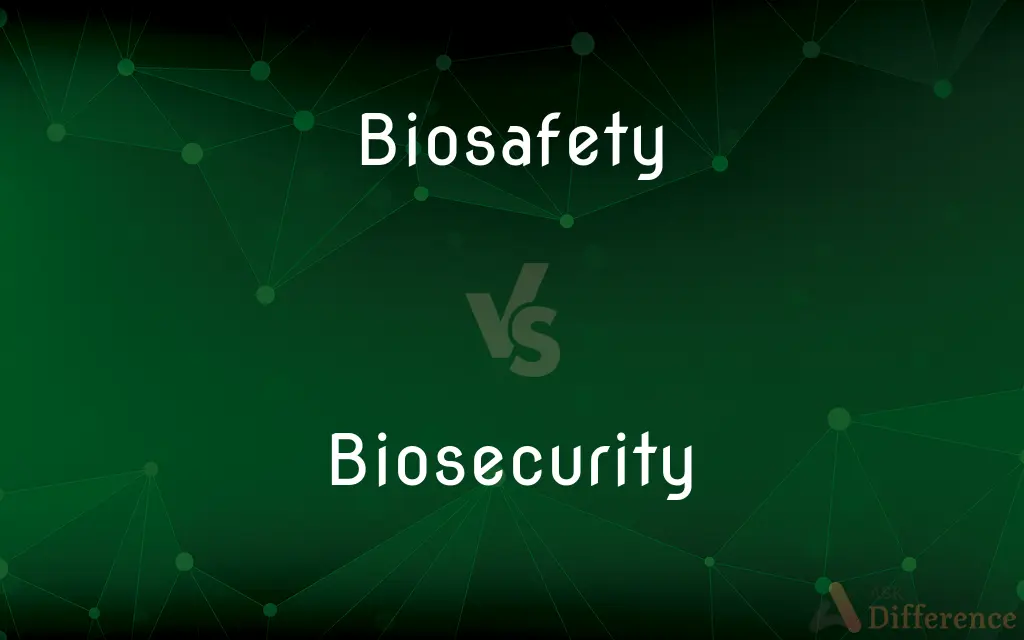Biosafety vs. Biosecurity — What's the Difference?
Edited by Tayyaba Rehman — By Fiza Rafique — Updated on March 18, 2024
Biosafety focuses on protecting people and environment from harmful biological agents, emphasizing safe handling and containment. Biosecurity aims to prevent loss, theft, misuse, and intentional release of pathogens, focusing on access control and policy.

Difference Between Biosafety and Biosecurity
Table of Contents
ADVERTISEMENT
Key Differences
Biosafety is concerned with the principles, practices, and procedures implemented to ensure the safe handling, storage, and disposal of biological agents, such as bacteria, viruses, and toxins, to prevent accidental exposure or release into the environment. Biosecurity, on the other hand, deals with the protection, control, and accountability of biological materials within laboratories and facilities to prevent their unauthorized access, theft, misuse, or intentional release.
Biosafety levels (BSL) categorize the containment precautions required to isolate dangerous biological agents in an enclosed facility. The levels range from BSL-1, which is the lowest level of containment, to BSL-4, which is the highest and required for the most dangerous pathogens. Biosecurity measures, however, are tailored to the specific risks associated with the possession, use, and transfer of pathogens and toxins, and include personnel reliability programs, inventory control, and access restrictions.
While biosafety aims to protect individuals and the environment from the accidental effects of pathogens, by containing them and implementing safety procedures, biosecurity's goal is to protect pathogens from individuals, preventing their misuse and ensuring that they remain only in the hands of authorized and competent personnel. This includes measures to identify and protect against threats that could lead to the deliberate misuse of biological agents.
Biosafety is often implemented through laboratory design and operational practices, such as the use of biosafety cabinets, autoclaves, and personal protective equipment, to contain pathogens and reduce exposure risks. Biosecurity, whereas, involves administrative controls, physical security, and information security to safeguard sensitive biological materials from theft or diversion to harmful uses.
The synergy between biosafety and biosecurity is crucial for the comprehensive protection against biological risks. Effective biosafety practices reduce the risk of accidental harm, while robust biosecurity measures mitigate the risk of intentional misuse. Together, they form an integral part of national and international efforts to ensure public health, agricultural integrity, and overall global security.
ADVERTISEMENT
Comparison Chart
Primary Focus
Safe handling and containment of biological agents to protect people and the environment.
Prevention of loss, theft, misuse, and intentional release of pathogens.
Main Concerns
Accidental exposure or release.
Unauthorized access and intentional misuse.
Practices
Laboratory safety protocols, personal protective equipment, containment measures.
Personnel reliability programs, inventory control, access restrictions.
Levels/System
Biosafety levels (BSL-1 to BSL-4) categorize containment requirements.
Measures tailored to specific risks associated with pathogens and toxins.
Goal
Protect individuals and environment from pathogens.
Protect pathogens from individuals, preventing misuse.
Compare with Definitions
Biosafety
The practice of preventing unintentional exposure to pathogens and toxins or their accidental release.
The lab adopted strict biosafety measures to handle the new virus strain safely.
Biosecurity
Measures to protect biological agents from theft, loss, or misuse.
The facility's biosecurity plan includes strict access controls to sensitive areas.
Biosafety
Protective measures to ensure the safety of personnel working with biological agents.
All technicians must wear appropriate PPE as part of the lab's biosafety guidelines.
Biosecurity
Efforts to prevent the intentional release of harmful biological agents.
International biosecurity initiatives aim to prevent the proliferation of biological weapons.
Biosafety
A set of containment principles, technologies, and practices implemented to prevent infection.
Biosafety cabinets are essential in labs to contain airborne pathogens.
Biosecurity
Policies and practices to prevent the use of dangerous pathogens in bioterrorism.
National biosecurity regulations require background checks for personnel handling select agents.
Biosafety
Procedures to safely handle and dispose of infectious materials.
The biosafety protocol includes autoclaving waste before disposal.
Biosecurity
Systems to ensure that only authorized personnel can access high-consequence pathogens.
The lab's biosecurity measures include biometric access controls.
Biosafety
The categorization of labs based on their level of containment, from BSL-1 to BSL-4.
Research on highly infectious diseases is conducted in BSL-4 laboratories.
Biosecurity
The safeguarding of biological materials to prevent their unauthorized access.
Biosecurity training for staff emphasizes the importance of controlling access to pathogen inventories.
Biosafety
Biosafety is the prevention of large-scale loss of biological integrity, focusing both on ecology and human health. These prevention mechanisms include conduction of regular reviews of the biosafety in laboratory settings, as well as strict guidelines to follow.
Biosecurity
The protection of humans against bioweapons, or from the accidental release of biohazards
Biosafety
The set of measures taken to ensure the safe handling of biohazardous materials, such as pathogens, biological contaminants, and genetically modified organisms, especially to prevent their accidental spread beyond a laboratory or research facility.
Biosecurity
Biosecurity refers to measures aimed at preventing the introduction and/or spread of harmful organisms (e.g. viruses, bacteria, etc.) to animals and plants in order to minimize the risk of transmission of infectious disease.
Biosafety
Protection from potential harm from biological agents, such as infectious microbes or modified genes.
Biosecurity
The set of measures taken to limit or counter the threat posed by sudden widespread disease or biological contamination, as from biological warfare, acts of bioterrorism, or pandemic outbreaks, including measures for increasing public safety and preparedness as well as procedures aimed at restricting access to biohazardous materials or to information relating to their production.
Biosafety
Safety from exposure to infectious agents
Biosecurity
The protection of plants and animals against harm from disease or from human exploitation
Common Curiosities
What are biosafety levels?
Biosafety levels (BSL-1 to BSL-4) are categories that define the containment precautions required to work with different types of biological agents safely.
Why is biosecurity important in laboratories?
Biosecurity is crucial to prevent the misuse of biological materials that could be used in bioterrorism or other malicious activities.
What is the main goal of biosafety?
Biosafety aims to protect individuals and the environment from harmful biological agents through safe handling, containment, and disposal practices.
Can biosafety and biosecurity measures overlap?
Yes, they often overlap and complement each other, with both sets of measures contributing to the comprehensive protection against biological risks.
How do institutions implement biosafety?
Institutions implement biosafety through laboratory design, operational practices, safety equipment, and training to contain pathogens and reduce exposure risks.
Are there international guidelines for biosafety and biosecurity?
Yes, there are international guidelines and standards, such as those provided by the WHO and the CDC, to help ensure global biosafety and biosecurity practices.
How does biosecurity differ from biosafety?
Biosecurity focuses on preventing the unauthorized access, theft, misuse, or intentional release of pathogens, emphasizing control and policy.
How do biosafety cabinets contribute to biosafety?
Biosafety cabinets are essential in providing an enclosed, ventilated laboratory workspace that helps to prevent contamination and exposure to pathogens.
What is a Select Agent Program?
The Select Agent Program regulates the handling and security of agents and toxins that could pose a severe threat to public, animal, or plant health.
What role does biosecurity play in public health?
Biosecurity plays a vital role in protecting public health by securing dangerous pathogens and preventing their potential use as biological weapons.
What is a biosecurity plan?
A biosecurity plan is a comprehensive strategy that outlines the measures and practices to prevent the unauthorized access, theft, and misuse of biological materials.
How do biosafety practices protect the environment?
Biosafety practices, such as proper waste disposal and containment, prevent the accidental release of pathogens into the environment, protecting ecosystems.
Can biosecurity measures affect research access?
While necessary for security, biosecurity measures can sometimes limit access to biological materials, impacting research flexibility.
Share Your Discovery

Previous Comparison
Speaking vs. Speak
Next Comparison
Apricot vs. DamascusAuthor Spotlight
Written by
Fiza RafiqueFiza Rafique is a skilled content writer at AskDifference.com, where she meticulously refines and enhances written pieces. Drawing from her vast editorial expertise, Fiza ensures clarity, accuracy, and precision in every article. Passionate about language, she continually seeks to elevate the quality of content for readers worldwide.
Edited by
Tayyaba RehmanTayyaba Rehman is a distinguished writer, currently serving as a primary contributor to askdifference.com. As a researcher in semantics and etymology, Tayyaba's passion for the complexity of languages and their distinctions has found a perfect home on the platform. Tayyaba delves into the intricacies of language, distinguishing between commonly confused words and phrases, thereby providing clarity for readers worldwide.














































